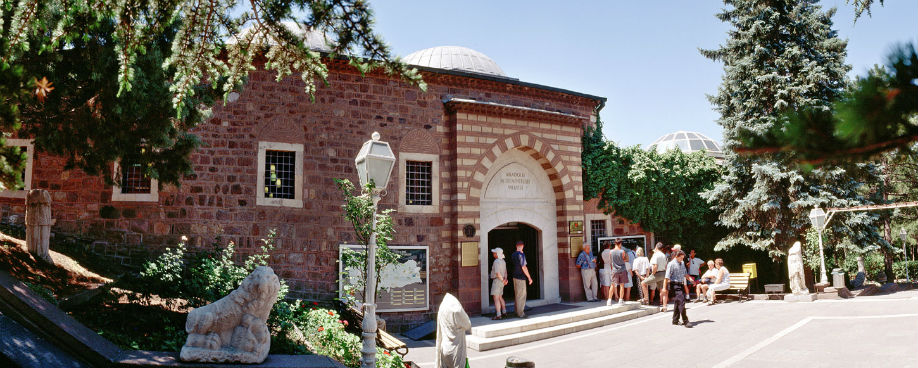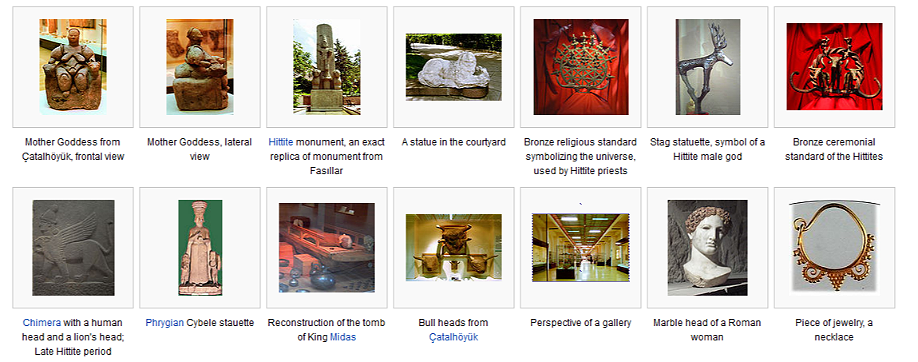The superb Museum of Anatolian Civilisations is the perfect introduction to the complex weave of Turkey’s ancient past, housing artefacts cherry-picked from just about every significant archaeological site in Anatolia.
The museum is housed in a beautifully restored 15th-century bedesten (covered market). The 10-domed central marketplace houses reliefs and statues, while the surrounding hall displays exhibits from the earlier Anatolian civilisations: Palaeolithic, Neolithic, Chalcolithic, Bronze Age, Assyrian, Hittite, Phrygian, Urartian and Lydian. The downstairs sections hold classical Greek and Roman artefacts and a display on Ankara’s history. Get there early to avoid the flood of tour groups and school parties.
The exhibits are chronologically arranged in a spiral: start at the Palaeolithic and Neolithic displays in the room to the right of the entrance, then continue in an anticlockwise direction, visiting the central room last.
Items from one of the most important Neolithic sites in the world Çatalhöyük, southeast of Konya – are displayed here. There’s a mock-up of the inside of a dwelling typical of those uncovered at the site, one of the most famous mother goddess sculptures unearthed from the excavations and wall paintings of hunting scenes.
Also on show are many finds from the Assyrian trading colony Kültepe, one of the world’s oldest and wealthiest bazaars. These include baked-clay tablets found at the site, which dates to the beginning of the 2nd millenium BC.
One of the striking Hittite figures of bulls and stags in the next room used to be the emblem of Ankara. The Hittites were known for their relief work, and some mighty slabs representing the best pieces found in the country, generally from around Hattuşa, are on display in the museum’s central room.
Most of the finds from the Phrygian capital Gordion, including incredible inlaid wooden furniture, are on display in the museum’s last rooms. The exhibits also include limestone blocks with still-indecipherable inscriptions resembling the Greek alphabet, and lion- and ram-head ritual vessels that show the high quality of Phrygian metalwork.
Urartian artifacts are also on display here. Spurred by rich metal deposits, the Urartians were Anatolia’s foremost metalworkers, as the knives, horse-bit, votive plates and shields on display demonstrate. There are also terracotta figures of gods in human form, some revealing their divine powers by growing scorpion tails, and neo-Hittite artefacts.
Downstairs, classical-period finds and regional history displays provide a local picture. Excavations have unearthed a Roman road near the Column of Julian, and Ankara has its own ‘missing link’, the 9.8-million-year-old Ankarapithecus (a 30kg, fruit-eating primate).




This is a wonderful place in which one can indulge in learning–especially about all the assorted armies, conquerors and empires that have wandered across Turkish history. Wonderful displays and a fine collection of exceptional artifacts. Also, the location is spectacular especially if you climb to the top of the hill on which the Museum is located.
We stayed at the Divan Hotel up the street so we walked here and although we were told only one room was open, we still went in. It was worth it but a bit of a disappointment to be still charged full price. There were many students there and they like talking to foreigners.
One of the Americal archeologist told me that this is one of the best archeological museum she has ever seen. When we visited some parts of it were under modification. It has got some 70 artefacts – some of them from 5000 BC. They have good collection of coins, statues and stone pieces etc. This is well maintained facility. There…
its mostly about the the hitties who rules anatolia 3000 yrs ago..lot of artficats,sculptures druing that era. there is a small section on the neolithic era as well
First, look at the building itself–dating from the 15th century, it is a restored covered market with stunning architecture. One of the exhibits dates back to the earliest known human community, and subsequent civilizations including Uratu, Hattie, Hittite, Phrygian and Assyrian. We especially enjoyed seeing the "in situ" photos showing the items as they were found before excavating for display…
Excellent collection and display. Well worth a morning of your time. Gift shop was very nice. And had a coffee shop with great Turkish coffee.
Most of the salons were closed (and I don't think hey told you that before you bought your ticket). Enjoyed the displays and grounds are lovely.
GIves a good insight into the long history of the Anatolia region – not very big but crammed with artifacts
Our guide was disappointed that the museum was under renovation and that there were parts we couldn't see. Personally, I felt the size of the portion of the museum that was open was just right. It seemed do-able and not overwhelming. But then again, I didn't know what I was missing.
The exhibts are well displayed, not cluttered and spread…
Statutes, hand tools, jewellery from every period from mostly central anatolia, lots of lots artifacts, great displays and very explanatory signs.
If interested in archeology and history; a landmark not to miss.